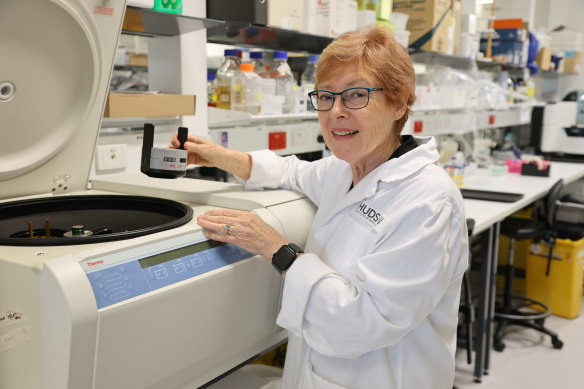
Caroline Gargett, a professor at the Hudson Institute of Medical Research and adjunct professor at Monash University, has personal reasons for wanting to see better results for women.
Like Maconochie, Gargett suffered a levator avulsion – where the pelvic floor muscle tears off the pubic bone – while giving birth as a young woman.

Professor Caroline Gargett is working on combing stem cells with biodegradable mesh to help repair pelvic tissue for thousands of women affected every year by pelvic organ prolapse.
The injury was not detected and resulted in a prolapse so confronting that she could see her cervix protruding. It meant Gargett had to have a hysterectomy, aged 35, after having her third child.
“Forty per cent of women will experience it (prolapse) at one time or another … the cause is birth injury from having a vaginal birth; it’s quite staggering to think about it being just ignored, but that’s exactly what happens,” she says.
Loading
Gargett and her Hudson Research Institute of Medical Research colleague, Dr Shayanti Mukhergee, have recently published papers on their work blending 3D-printed degradable mesh with endometrial stem cells (obtained from womb lining), which have extraordinary regenerative properties.
The technique uses “bio-ink” to introduce the cells into polymer mesh, creating a device that will not cause inflammation, whose structure will eventually dissolve as the cells establish new tissue, and which could produce dramatic improvements for many women with prolapse.
Most mothers-to-be are not told about prolapse or prevention before giving birth, says urogynaecologist Associate Professor Anna Rosamilia, because it is an awkward topic that is rarely discussed.
“These are deeply personal and intimate topics; there is a sense of shame and devastation that their body has let them down,” says Rosamilia.
“Having said that, when you discuss these, often people will talk it over with friends and say, ‘it’s much more common than I realised’.” Older mothers who have big babies and forceps deliveries are the most likely to experience prolapse, and the injuries are most likely to occur during their first birth.
The prolapse may occur early after a first traumatic birth or many decades later.
Pelvic organ prolapse is currently difficult to fix, says Rosamilia, because there is no way yet to repair the muscles involved. Development of a scaffold to support them that is compatible with the body and improves healing and strength is “the dream”.
“Even more of a dream is to try to identify women who have had a forceps delivery, or are diagnosed with this sort of muscle injury after birth and have some kind of intervention; cellular therapy or an injection that improves healing of the tissue,” she said.
Loading
Gargett’s team is also researching prolapse prevention through stem cell therapy.
“An even greater goal is to prevent birth injury occurring,” says Gargett. “Development of new cell-based therapies, and new ways of making a mesh material that will degrade, will bring hope for women in an area no one talks about.”
The Morning Edition newsletter is our guide to the day’s most important and interesting stories, analysis and insights. Sign up here.









 Add Category
Add Category